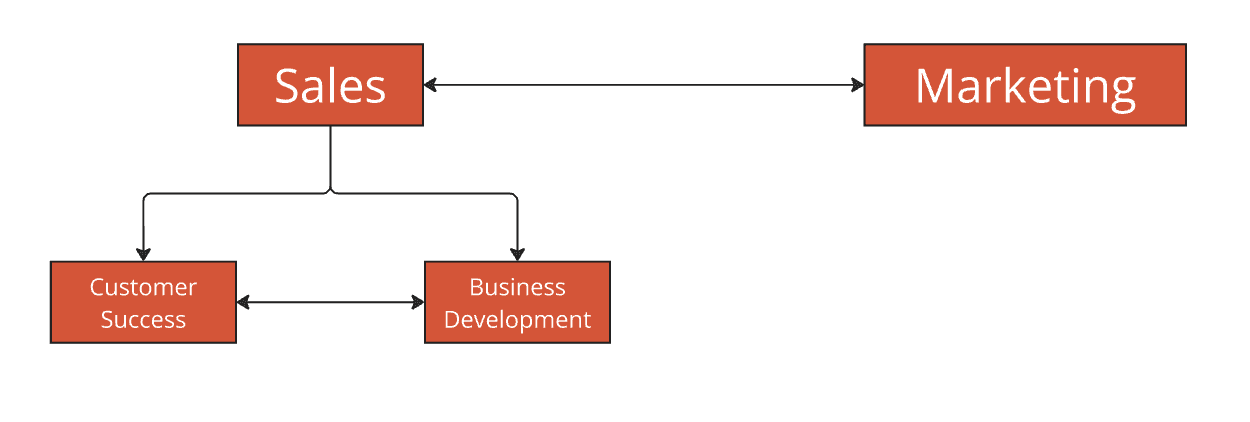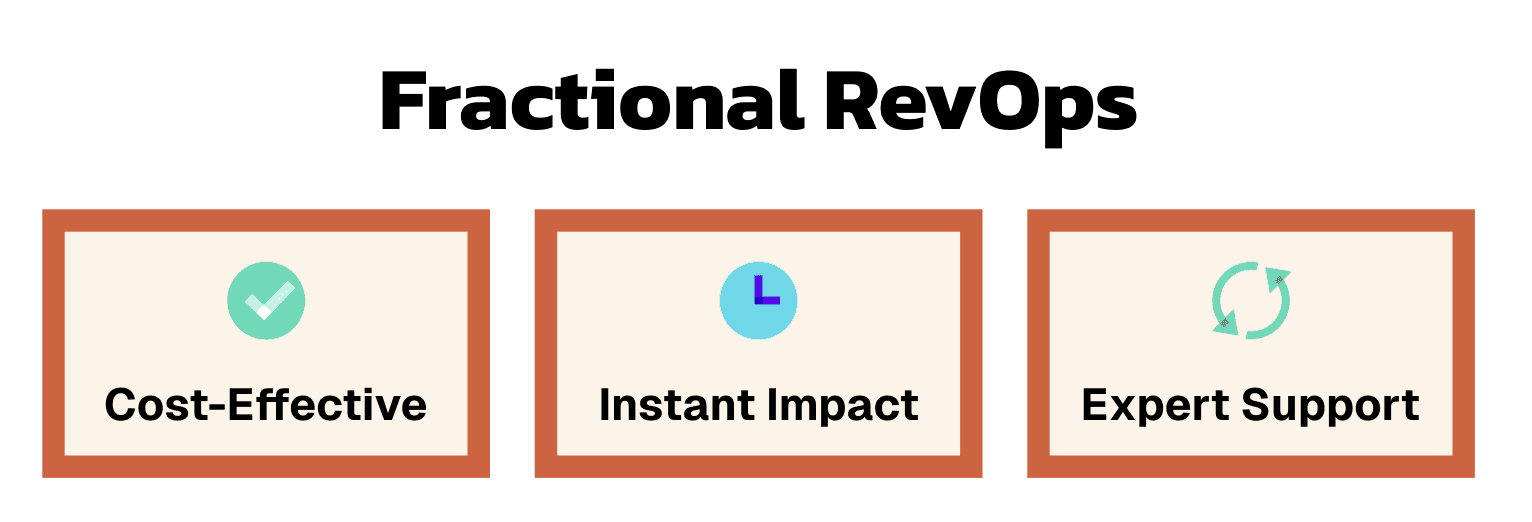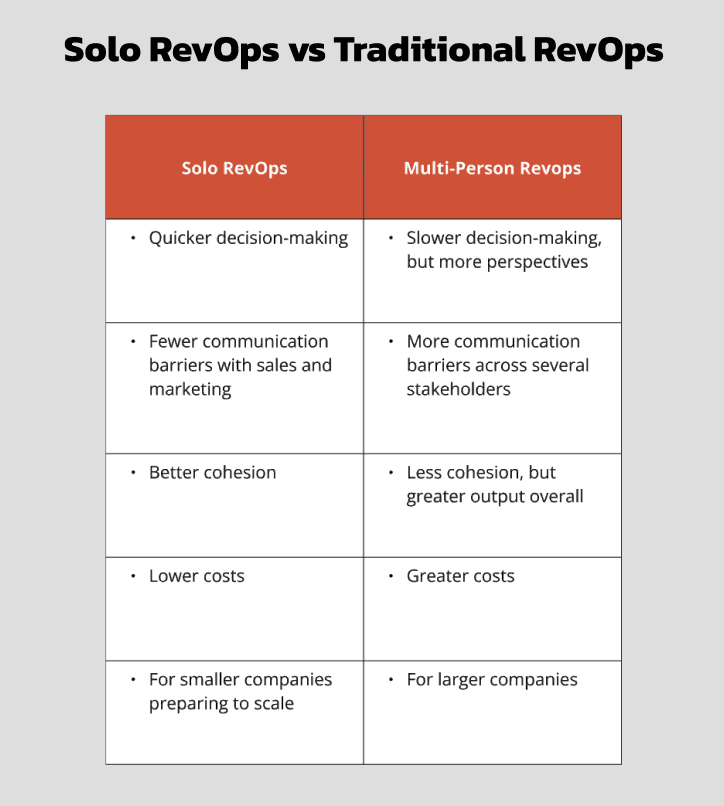Mastering Solo RevOps: A Comprehensive Guide
Learn how to implement Solo RevOps into your startup or small business to remove inefficiencies and achieve your revenue goals.
1. Introduction to Solo RevOps
What is Solo RevOps?
Solo RevOps (short for Revenue Operations) describes a one-person team in a business tasked with the alignment of sales, marketing, and customer success functions.

The idea behind Solo RevOps is relatively simple yet powerful:
Instead of having multiple professionals handling separate segments of the revenue process, one person orchestrates it all.
This can mean, for instance, aligning your sales strategies directly with your marketing campaigns or ensuring that customer feedback loops back into your product development seamlessly.
This Solo RevOps structure is most commonly seen in startups and small businesses, often unintentionally.
Usually, these businesses will opt for Fractional RevOps assistance (often called "RevOps As A Service") when they do not have the resources or expertise to hire a full-time RevOps professional.

If you are a sales lead or marketing director, you may wear multiple hats:
From managing sales calls to tackling customer inquiries and analysing campaign data.
You are using Solo RevOps principles to ensure that all components work together to maximise revenue.
Benefits of Solo RevOps vs Multi-Person RevOps

The significance of Solo RevOps cannot be overstated.
As businesses evolve, the necessity for cohesive strategies that eliminate silos has become paramount.
Here are a few key reasons why Solo RevOps is crucial for your company:
Streamlined Processes: Solo RevOps removes redundancy by ensuring that one person is responsible for understanding and managing the entire revenue cycle. This leads to quicker decision-making and better cohesion than operating across a multi-person RevOps team.
Enhanced Communication: With a single point of contact, communication barriers diminish, promoting collaboration among sales, marketing, and customer success teams. This fosters a unified approach to revenue generation.
Informed Decision Making: Having access to sales, marketing, and customer data in one place allows for real-time insights, helping businesses adjust strategies on the fly. This is highly valuable to fast-growth startups, who need to constantly adapt their GTM strategy.
Cost-Effective: For smaller organisations, employing a full RevOps team may not be feasible. Solo RevOps offers a fraction of that capability, allowing companies to optimise operations without significant financial investment.
Head Start On The Inevitable: Like it or not, RevOps will be required once your company reaches a certain size. Adopting Solo RevOps enables smaller organisations to remain ahead of the curve and avoid future bottlenecks.
In essence, Solo RevOps empowers businesses, big or small, to adopt a holistic approach to revenue management, enhancing their ability to not only meet but exceed their financial goals.
Through this innovative approach, companies can ensure long-term sustainability and growth in an increasingly competitive marketplace.
2. Getting Started With Solo RevOps
Setting Goals and Objectives
As with most things, building an effective RevOps framework starts with the establishment of clear goals and objectives.
This is even more critical when you operate as a Solo RevOps team, because your time will be heavily limited.
These goals and objectives serve as the foundation upon which all operations are conducted.
For instance, let’s say a small InsurTech company aims to increase its annual recurring revenue (ARR) by 25% over the next year.
This ambitious goal would require setting specific, measurable objectives like:
Increase lead generation by 40%
Reduce sales cycle duration from 45 to 30 days
Boost customer retention rate to 90% or higher
Setting these objectives not only provides a roadmap for the RevOps but also fosters accountability.
Don't go overboard with making all of them SMART, however, as this can cause reduced fluidity and ability to quickly adapt, which is key for hyper-growth companies.
Developing A Plan

The second step is to expand on these goals and objectives to define a more holistic framework and identify specific operational leaks:
1. STRATEGY:
How do these goals align with your current GTM strategy?
What could be changed about your current strategy to find better alignment?
2. PROCESSES:
Which end-to-end processes need improving?
How will you track the impact of the changes you make?
Which data will you need to collect?
3. WORKFLOW:
Which manual process can be automated?
Which tool will you use to automate them?
Which processes should be assigned to marketing, and which to sales?
Which processes should be the responsibility of both teams?
4. ANALYSIS:
What problems exist in your sales pipeline, marketing funnel, revenue forecasts, territory plan, commission allocation and customer health?
How can you collect and use data to inform action and improve these?
5. TECH:
Which RevOps tools are currently in place that could be upgraded?
Are there any tools being used that cause more harm than good?
How bloated is the CRM, and how is this affecting the team's ability to get work done?
If you're looking to shortcut any of this - a friendly reminder that RevOps Consulting provides you with RevOps expertise at a fraction of the cost of hiring full-time…
Aligning Sales and Marketing Strategies
Once a framework is set, the next critical step is to align sales and marketing strategies.
This alignment is essential for driving revenue efficiency and consistency across the board.
Across startups, marketing and sales are driven as two separate entities.
This can cause frustration and inefficiency amongst both teams, because goals, methods, and messaging are inconsistent.
As a consequence, both teams can feel as though they are fighting an uphill battle to get leads in the door and close deals, meaning chances of missing revenue targets skyrocket.
This is exactly why RevOps is needed.
A practical example can be drawn from a mid-sized FinTech company:
They integrated their sales and marketing teams by using a shared CRM system.
This allowed both teams to monitor customer behaviour, leading to more personalised marketing campaigns, which in turn facilitated prospecting.
Here are a few high-level strategies to achieve alignment that you can implement today:
Joint Communication: Schedule regular joint meetings to discuss progress, share insights, and brainstorm new ideas. This creates a culture of collaboration rather than competition. Underlying issues can be exposed and dealt with quickly.
Unified Lead Scoring: Develop a shared scoring system that measures leads based on their likelihood to convert.
Feedback Loops: Establish a system for sales to provide feedback to marketing on lead quality and the source of those leads. This can inform future campaigns and rectify any gaps in targeting.
In essence, by setting clear goals and fostering alignment between sales and marketing, businesses can create a robust RevOps framework that drives growth and enhances overall performance.
This approach not only helps organisations meet their revenue goals, but also cultivates a cohesive culture focused on shared success.
3. The Best Tools for Solo RevOps
Choosing the Right Tech Stack
As you build and refine your Solo RevOps strategy, one of the most crucial steps is selecting the right tech stack.
The right tools not only streamline processes but also enhance productivity, enabling Solo RevOps professionals to manage various functions effectively.
When choosing a tech stack, consider the specific needs of your operation.
Here are some essential tools to incorporate into your RevOps arsenal:
CRM Software: This one is pretty much a given, as the majority of a RevOps consultant's work will take place here. A robust Customer Relationship Management system, like HubSpot or Salesforce, helps in storing customer data, tracking interactions, and managing sales pipelines. Many RevOps consultants are also experienced in up-and-coming CRM systems, including Attio, Pipedrive and Monday.com.
Marketing Automation Tools: Based on your plan, you may have access to marketing tools within your CRM. Alternatively, tools like Mailchimp or Marketo allow you to automate and optimise marketing campaigns, create landing pages, and publish newsletters. RevOps consultants are adept at integrating these tools with your CRM so that there is as little admin as possible for marketing and sales teams.
Data Analytics Tools: Most CRM systems will allow you to create custom dashboards to interpret key data and draw conclusions. However, for more comprehensive analysis, exporting CRM data to platforms like Microsoft Excel (or Google Sheets for those ahead of the curve) is best for driving informed decision-making.
Communication Tools: Slack is an obvious choice for many startups for rapid communication. Notion is an excellent all-in-one tool for project management and easy-to-access documentation to ensure consistency across your GTM team.
Worflow Automation Tools: Low-code platforms like Zapier or Make.com can bridge the gap between various tools that may not have native integrations, and allow for much more advanced automation potential.
Most startups will typically begin with a basic CRM.
This is no problem for a 5-person company to track deals and send a few emails.
But once your company reaches a certain size, you're going to outgrow your primitive tech stack.
To unlock the next level of growth for your business, marketing automation, sales automation, and data-based decision making become increasingly more critical.
Book a call with us if you need some help getting started.
Integrating Tools for Efficiency
Once you have selected the tools that make up your tech stack, the next challenge is integrating them to maximise efficiency.
Tool integration ensures that data flows seamlessly between platforms, providing a single source of truth that enhances collaboration and decision-making.
Here are some effective strategies for integrating your tools:
Use APIs: Most modern software solutions offer APIs (Application Programming Interfaces) that enable you to connect different platforms. This allows customer data, lead information, and interactions to sync in real-time across your systems, and therefore across your teams. Many platforms will have native integrations that allow you to harness the power of an API without coding knowledge.
Regular Maintenance: Many fast-growing businesses are completely blind to their own inefficiencies. GTM leaders can be left doing low-value tasks for hours simply because "they didn't know it could be automated". This is why companies like RevOps Consulting provide you with regular automation audits to keep your sales and marketing teams moving at twice the speed of the competition.
Benefits of RevOps Automation:
Eliminate manual data entry
Prioritisation of leads
Assign leads to the correct SDRs or AEs
Send marketing emails at the optimal time
Improve data accuracy and consistency
Increase cross-team communication
Drive better insights and decision-making
Ultimately increase revenue and profitability.
4. Data-Driven Decision Making in Solo RevOps
Collecting and Analysing Sales Data
Once you have your tech stack in place and your tools integrated, the next vital step in Solo RevOps is mastering data-driven decision making.
The first phase in this process involves systematically collecting and analysing sales and marketing data:
This data serves as the backbone of your operational insights, guiding decisions that can affect your overall revenue growth.
Key data points to focus on when developing your CRM dashboard include:
Lead Sources: Track where most of your leads are coming from to identify the most effective channels.
Conversion Rates: Analysing the percentage of leads that convert provides insights into the effectiveness of your sales process.
Sales Cycle Length: Understanding how long it takes to close a deal can help identify bottlenecks in the process.
Sales Rep Performance: People are your best source of leverage. Identify your best performers to put on your biggest deals, and give support to those who need it without wasting time on those who don't.
Implementing Data-driven Strategies
Once you have gathered and analysed your sales data, the next step is to implement strategies based on your findings.
This transition from insights to action can make all the difference in maximising revenue potential.
Here are some effective strategies to consider:
Prioritising Top Lead Sources: Double-down on your most effective channels, lead magnets and offers.
Optimising Lead Nurturing: Use insights from your conversion rate data to optimise your funnel or sales pipeline. Find out exactly where most prospects lose interest, and put extra effort into fixing that bottleneck.
Adjusting Sales Tactics: If your data reveals a longer sales cycle, it may be time to revisit your sales pitch or offer additional training to your sales team.
Restructuring The Team: Make data-driven decisions about which rep should be on each deal to maximise your chances of closing.
Personalising Customer Interactions: Use customer data to create individualised communication strategies. This personalisation increases engagement and boosts customer satisfaction, ultimately helping get deals across the line.
Ultimately, embedding data-driven decision making into your Solo RevOps approach empowers you to make informed choices.
This enhances performance across the board, allowing for continual growth and adaptation in a dynamic business landscape.
By focusing on collecting and analysing sales data, and then implementing strategies based on those insights, you set the stage for sustainable success.
5. Scaling Your Solo RevOps Efforts
Outsourcing Fractional RevOps Expertise
As your Solo RevOps efforts begin to pay off, scaling your operations becomes essential to sustain growth and meet increasing demands.
One of the best ways to do this is looking for fractional RevOps consulting.
Or in other words: RevOps as a Service.
Most startups find that this is a happy medium between having no RevOps, and hiring full-time.
Benefits of fractional RevOps include:
Much lower costs and effort than hiring full-time
On-demand RevOps expertise (without the headaches of managing a team)
Driving permanent improvements
Hiring and Training a RevOps Team
Once RevOps becomes more established in the business, you may need to start hiring and training a dedicated RevOps team.
When considering who to hire, look for candidates with a blend of skills and experience in sales, marketing, and data analysis.
Ideal team members should have:
Analytical Skills: They need to interpret data effectively. Manipulating data is one thing, but connecting insights to actionable strategies is where the real value lies.
Communication Skills: Clear communication is vital for bridging gaps between departments and understanding the specific issues within the go-to-market engine.
Technical Proficiency: Familiarity with CRM systems, automation and Excel ensures they can hit the ground running.
RevOps Consulting provides assistance in sourcing full-time RevOps hires for your business, especially if you are growing your team from zero to one.
Be sure to contact us to avoid making the wrong hire for your Solo RevOps team.






